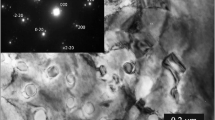Abstract
An example of an isothermal thermodynamic phase diagram of a quaternary system composed of a binary alloy and two oxidants has been calculated under appropriate values of the stability of the corresponding compounds, assuming that each metal forms only one compound with each oxidant. Initially, two-dimensional sections of the complete three-dimensional diagram made along planes corresponding to constant values of one of the variables involved were examined in detail. The actual structure of this type of three-dimensional diagram was then discussed by analyzing the shape and the boundaries of the various regions corresponding to the conditions of stability of each phase taken separately or in combination with other phases.











Similar content being viewed by others
References
C. S. Giggins and F. S. Petit, Oxidation of Metals 14, 363 (1980).
A. Rahmel, M. Schorr, A. Velasco-Tellez, and A. Pelton, Oxidation of Metals 27, 987 (1991).
N. Birks, G. H. Meier, and F. S. Pettit, Introduction to the High Temperature Oxidation of Metals (Cambridge University Press, Cambridge, 2006).
F. Gesmundo, F. Viani, and Y. Niu, Oxidation of Metals 42, 409 (1994).
F. Gesmundo, F. Viani, Y. Niu, and D. L. Douglass, Oxidation of Metals 42, 464 (1994).
F. Gesmundo, Y. Niu, and F. Viani, Oxidation of Metals 43, 379 (1995).
F. Gesmundo and B. Gleeson, Oxidation of Metals 45, 51 (1996).
F. Gesmundo, F. Viani, and Y. Niu, Oxidation of Metals 47, 355 (1997).
Acknowledgements
Financial support by the National Natural Scientific Foundation of China (NSFC) under the research projects No. 50671114 is gratefully acknowledged.
Author information
Authors and Affiliations
Corresponding author
Appendix
Appendix
Using the notation introduced above, the equilibrium constants for the formation of the two oxides have the general form
and
Similarly, the equilibrium constants for the formation of the two chlorides have the form
and
For the calculation of point E1, with x = x(E1) and P(O2) = P(O2,E1), one variable, e.g. P(O2,E1) is eliminated from Eqs. 1 and 2 and the resulting equation is solved for x(E1). Then, substitution of x(E1) into one of the two equations yields P(O2,E1). In the same way, for the calculation of point E2, with x = x(E2) and P(Cl2) = P(Cl2,E2), the latter variable is eliminated from Eqs. 3 and 4, obtaining x(E2). After this, substitution of x(E2) into either Eqs. 3 or 4 yields P(Cl2,E2).
Other important parameters involved in the construction of the complete 3D phase diagram are P(Cl2,E1) and P(O2,E2), already defined earlier. The first of them is calculated by setting x = x(E1) in Eq. 4 and solving for P(Cl2). Similarly, P(O2,E2) is calculated by setting x = x(E2) in Eq. 2 and solving for P(O2). With the present choice of the various equilibrium constants, the combination of P(O2,E1) and P(Cl2,E1) corresponds to a condition of equilibrium between an alloy with x = x(E1) and a mixture of AO, ACl2 and BO (point η1 of the 3D phase diagram), while the combination of P(O2,E2) and P(Cl2,E2) corresponds to a condition of equilibrium between an alloy with x = x(E2) and a mixture of ACl2, BO and BCl2 (point η2 of the 3D phase diagram).
Rights and permissions
About this article
Cite this article
Wang, S., Ni, C.S., Gesmundo, F. et al. Isothermal Phase Diagrams of Binary Alloys and Two Oxidants. Oxid Met 73, 419–453 (2010). https://doi.org/10.1007/s11085-009-9186-6
Received:
Revised:
Published:
Issue Date:
DOI: https://doi.org/10.1007/s11085-009-9186-6




